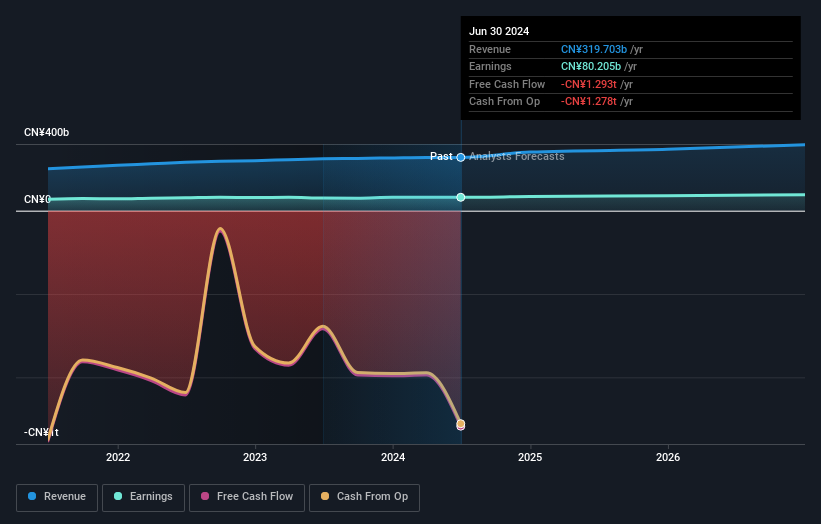Pulling back 9.1% this week, Postal Savings Bank of China's HKG:1658) one-year decline in earnings may be coming into investors focus

These days it's easy to simply buy an index fund, and your returns should (roughly) match the market. But investors can boost returns by picking market-beating companies to own shares in. For example, the Postal Savings Bank of China Co., Ltd. (HKG:1658) share price is up 23% in the last 1 year, clearly besting the market return of around 18% (not including dividends). So that should have shareholders smiling. On the other hand, longer term shareholders have had a tougher run, with the stock falling 8.2% in three years.
Since the long term performance has been good but there's been a recent pullback of 9.1%, let's check if the fundamentals match the share price.
See our latest analysis for Postal Savings Bank of China
To quote Buffett, 'Ships will sail around the world but the Flat Earth Society will flourish. There will continue to be wide discrepancies between price and value in the marketplace...' One imperfect but simple way to consider how the market perception of a company has shifted is to compare the change in the earnings per share (EPS) with the share price movement.
Over the last twelve months, Postal Savings Bank of China actually shrank its EPS by 6.6%.
This means it's unlikely the market is judging the company based on earnings growth. Indeed, when EPS is declining but the share price is up, it often means the market is considering other factors.
We haven't seen Postal Savings Bank of China increase dividend payments yet, so the yield probably hasn't helped drive the share higher. And at a glance the revenue growth does not impress, though a closer look at revenue trends may reveal some form of insight.
You can see how earnings and revenue have changed over time in the image below (click on the chart to see the exact values).

Postal Savings Bank of China is well known by investors, and plenty of clever analysts have tried to predict the future profit levels. You can see what analysts are predicting for Postal Savings Bank of China in this interactive graph of future profit estimates.
What About Dividends?
When looking at investment returns, it is important to consider the difference between total shareholder return (TSR) and share price return. The TSR incorporates the value of any spin-offs or discounted capital raisings, along with any dividends, based on the assumption that the dividends are reinvested. It's fair to say that the TSR gives a more complete picture for stocks that pay a dividend. We note that for Postal Savings Bank of China the TSR over the last 1 year was 32%, which is better than the share price return mentioned above. And there's no prize for guessing that the dividend payments largely explain the divergence!
A Different Perspective
It's nice to see that Postal Savings Bank of China shareholders have received a total shareholder return of 32% over the last year. That's including the dividend. That's better than the annualised return of 5% over half a decade, implying that the company is doing better recently. Someone with an optimistic perspective could view the recent improvement in TSR as indicating that the business itself is getting better with time. It's always interesting to track share price performance over the longer term. But to understand Postal Savings Bank of China better, we need to consider many other factors. Even so, be aware that Postal Savings Bank of China is showing 1 warning sign in our investment analysis , you should know about...
Of course Postal Savings Bank of China may not be the best stock to buy. So you may wish to see this free collection of growth stocks.
Please note, the market returns quoted in this article reflect the market weighted average returns of stocks that currently trade on Hong Kong exchanges.
New: Manage All Your Stock Portfolios in One Place
We've created the ultimate portfolio companion for stock investors, and it's free.
• Connect an unlimited number of Portfolios and see your total in one currency
• Be alerted to new Warning Signs or Risks via email or mobile
• Track the Fair Value of your stocks
Have feedback on this article? Concerned about the content? Get in touch with us directly. Alternatively, email editorial-team (at) simplywallst.com.
This article by Simply Wall St is general in nature. We provide commentary based on historical data and analyst forecasts only using an unbiased methodology and our articles are not intended to be financial advice. It does not constitute a recommendation to buy or sell any stock, and does not take account of your objectives, or your financial situation. We aim to bring you long-term focused analysis driven by fundamental data. Note that our analysis may not factor in the latest price-sensitive company announcements or qualitative material. Simply Wall St has no position in any stocks mentioned.
About SEHK:1658
Postal Savings Bank of China
Provides various banking products and services for retail and corporate customers in the People’s Republic of China.
Flawless balance sheet and fair value.


